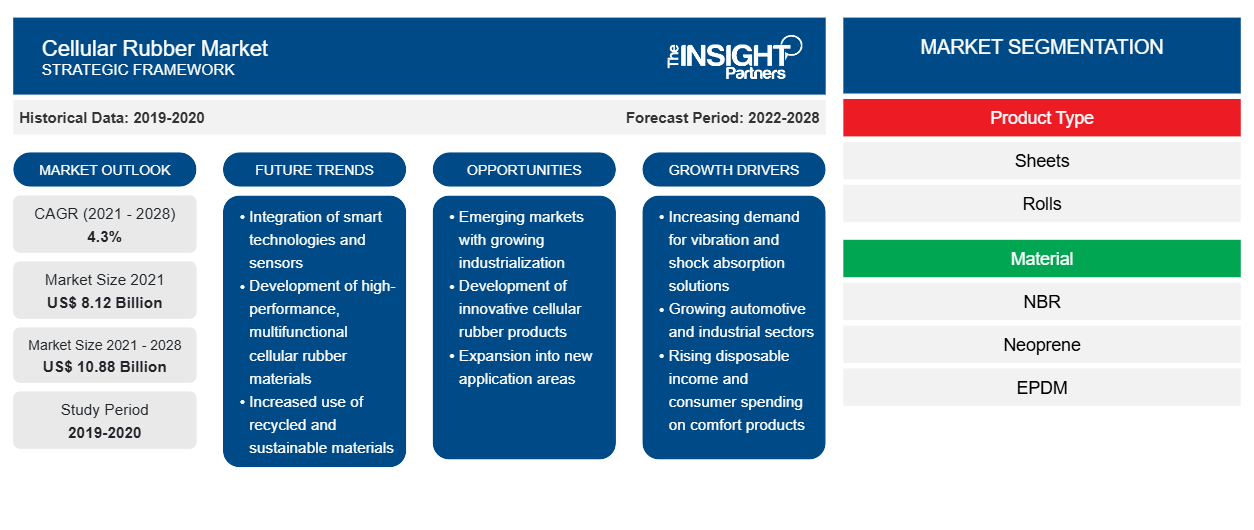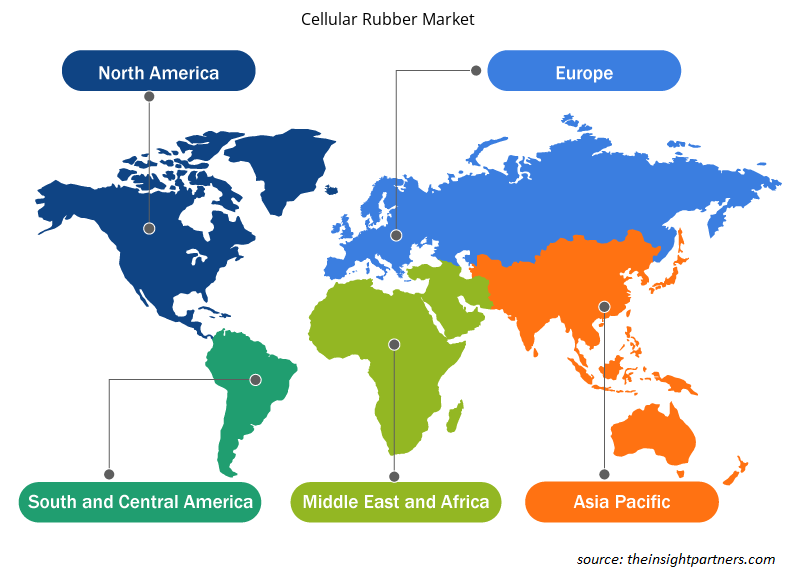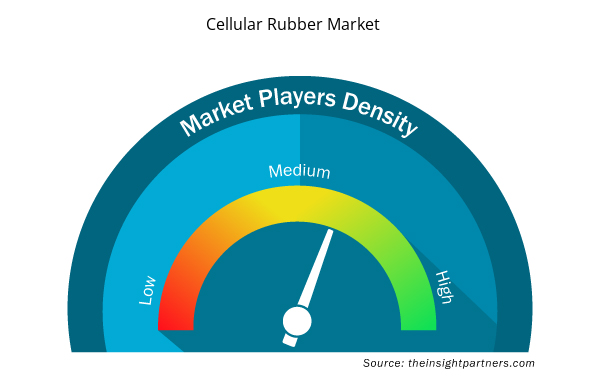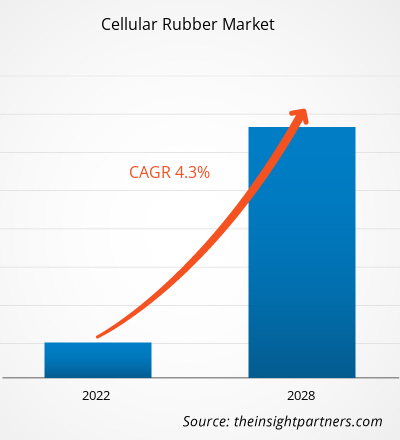The cellular rubber market was valued at US$ 8,115.83 million in 2021 and is projected to reach US$ 10,884.41 million by 2028; it is expected to grow at a CAGR of 4.3% from 2021 to 2028.
Cellular rubber is a type of foam rubber with a cell structure, wherein the cells are not interconnected. It is lightweight and compressible, and the rubber sheet is generally combined with microporosity cells to create the microcellular rubber sheet. These rubber sheets are commonly used to make the soles of shoes and slippers, and are primarily designed for comfort, flexibility, and durability. Cellular rubber is used in the automobile industry for a variety of applications, including sealing doors and tubes, and manufacturing tires, along with protecting vehicle body parts from harsh weather.
Europe is anticipated to hold the largest share of the cellular rubber market during the forecast period. The continuous progress of the automotive sector in this region is expected to fuel the cellular rubber market growth in this region. The growing demand for cars across the region is majorly attributed to the rising spending power of consumers, increasing number of double-income families, growth in working class, and rapid economic growth of the countries. Cellular rubber is being increasingly used in the automotive sector due to its sealing and noise reduction capabilities. The EPDM cellular rubber bonds quickly with metal and acts as an effective shield against weather; it also protects vehicles parts against environment and road surface conditions, and vibrations.
An interrupted supply of raw materials such as polyethylene and polypropylene, affecting production processes, has been a prime factor limiting the cellular rubber market growth during the COVID-19 pandemic. Additionally, a hike in crude oil prices have led to fluctuations in raw material prices, creating hurdles in the steady market growth. However, the cellular rubber market has witnessed a continuous demand from end-user industries such as automotive, construction, HVAC, and consumer goods. Moreover, as a part of economic recovery efforts, several sectors are strategically planning to invest in advanced and bio-based materials, such as cellular rubber, to address the growing need for environment friendly products. The automotive sector has started to gain momentum and is expected to witness significant growth in the coming years with the increasing sale of electric vehicles, eventually providing significant growth opportunities for the cellular rubber market players. Further, the demand for various medicines and COVID-19 vaccines has also surged during the COVID-19 pandemic across the world. The trade of these entities is propelling the need for suitable storage facilities and systems, eventually adding to the demand for cellular rubber as a sealant and insulator.
Customize This Report To Suit Your Requirement
You will get customization on any report - free of charge - including parts of this report, or country-level analysis, Excel Data pack, as well as avail great offers and discounts for start-ups & universities
Cellular Rubber Market: Strategic Insights

- Get Top Key Market Trends of this report.This FREE sample will include data analysis, ranging from market trends to estimates and forecasts.
You will get customization on any report - free of charge - including parts of this report, or country-level analysis, Excel Data pack, as well as avail great offers and discounts for start-ups & universities
Cellular Rubber Market: Strategic Insights

- Get Top Key Market Trends of this report.This FREE sample will include data analysis, ranging from market trends to estimates and forecasts.
Market Insights
Rising Demand for Cellular Rubber in Automotive Industry
The automotive industry is one of the key end users of cellular rubber due to its beneficial properties, such as sealing, shielding, and high compressibility. In automobiles, cellular rubber is primarily used in HVAC systems gaskets and seals, carburetor gaskets, noise, vibration and harmonics pads, wiring harness gaskets, lighting gaskets (interior and exterior), antenna gaskets, and vehicle trunk & door sealers. Although automotive has been a lucrative industry since long, it has been hit hard by the COVID-19 pandemic. The rising uptake of electric vehicles and imminent recovery of the automotive industry by 2022 from the pandemic’s impact are boosting automobile production, which, in turn, is driving the demand for cellular rubber. Asia Pacific is a prominent automotive market with the largest share in automobile production, especially in China, Japan, and India. Furthermore, there is a surge in demand for electric vehicles across the world. According to the EVAdoption reports, the sale of these vehicles is expected to reach 3,000,000 units by 2028 from 507,710 units in 2020 in the US.
Product Type Insights
Based on product type, the global cellular rubber market is segmented into sheets, rolls, and others. The sheets segment is anticipated to hold the largest share of the market during the forecast period. Cellular rubber is a type of foam rubber with a cell structure, wherein the cells are not interconnected. It is lightweight and compressible, and the rubber sheet is generally combined with microporosity cells to create the microcellular rubber sheet. The cellular rubber sheets find applications in industries such as automotive, aerospace, and electronics due to the ease of use associated with them and their ability to confer effective insulation. It is also an ideal choice for sealing or protection purposes. The cellular rubber sheets are made from different materials, such as NBR, neoprene, and EPDM, and they are available in various sizes and thicknesses. The EPDM cellular rubber sheets are being widely used as seals against liquids, aluminum and wooden windows, and door frames due to their excellent resistance to aging, weathering, ozone, oxygen, and other chemicals.
Material Insights
Based on material, the global cellular rubber market is segmented into nitrile butadiene rubber (NBR), neoprene, ethylene propylene diene monomer rubber (EPDM), silicone, and others. The EPDM segment is anticipated to hold the largest share of the market during the forecast period. The EPDM is a synthetic rubber made from crude oil and is synthesized via the polymerization of three monomers. Closed cell EPDM rubber is suitable for high-pressure applications manner. It is resistant to moisture, UV rays, and ozone. This makes the EPDM material a popular elastomer to be used in applications such as window sealing in vehicles and homes.
End User Insights
Based on end user, the global cellular rubber market is segmented into automotive, electronics, aerospace, and others. The automotive segment is anticipated to hold the largest share of the market during the forecast period.Cellular rubber is used for sealing doors and tubes and producing tires for the automotive sector; it also protects vehicle body part from extreme weather conditions. It is also used to manufacture body parts and chassis parts among others. The EPDM cellular rubber is often used in the automotive industry due to sealing attributes and noise reduction properties. The EPDM bonds present in the cellular rubber connect with metals to provide a strong barrier against weather and environment, road surface, and engine vibration. EPDM is also UV-resistant and waterproof. Thus, the versatility of EPDM cellular rubber enables it to be used in various automotive applications.
NDS-Seals, PANA Foamtec GmbH, ERIKS, Ridderflex, Polymax Ltd, Rogers Corporation, W. KÖPP GmbH & Co. KG, SEDO Chemicals Neoprene GmbH, Kautschuk- und Kunststoffteile GmbH, and Oskar Pahlke GmbH are among well-established players in the cellular rubber market. Companies in the market are adopting strategies such as product development, plant expansions, and mergers and acquisitions to expand their footprint worldwide and meet the growing demand from end users.
Cellular Rubber Market Regional Insights
The regional trends and factors influencing the Cellular Rubber Market throughout the forecast period have been thoroughly explained by the analysts at Insight Partners. This section also discusses Cellular Rubber Market segments and geography across North America, Europe, Asia Pacific, Middle East and Africa, and South and Central America.

- Get the Regional Specific Data for Cellular Rubber Market
Cellular Rubber Market Report Scope
| Report Attribute | Details |
|---|---|
| Market size in 2021 | US$ 8.12 Billion |
| Market Size by 2028 | US$ 10.88 Billion |
| Global CAGR (2021 - 2028) | 4.3% |
| Historical Data | 2019-2020 |
| Forecast period | 2022-2028 |
| Segments Covered |
By Product Type
|
| Regions and Countries Covered | North America
|
| Market leaders and key company profiles |
Cellular Rubber Market Players Density: Understanding Its Impact on Business Dynamics
The Cellular Rubber Market is growing rapidly, driven by increasing end-user demand due to factors such as evolving consumer preferences, technological advancements, and greater awareness of the product's benefits. As demand rises, businesses are expanding their offerings, innovating to meet consumer needs, and capitalizing on emerging trends, which further fuels market growth.
Market players density refers to the distribution of firms or companies operating within a particular market or industry. It indicates how many competitors (market players) are present in a given market space relative to its size or total market value.
Major Companies operating in the Cellular Rubber Market are:
- NDS-SEALS
- Pana Foamtec Gmbh
- Eriks
- Ridderflex
- Polymax Ltd
Disclaimer: The companies listed above are not ranked in any particular order.

- Get the Cellular Rubber Market top key players overview
Report Spotlights
- Progressive industry trends in the cellular rubber market to help players develop effective long-term strategies
- Business growth strategies adopted by developed and developing markets
- Quantitative analysis of the cellular rubber market for the period 2019–2028
- Estimation of the demand for cellular rubber across various industries
- Recent developments to understand the competitive market scenario and the demand for cellular rubber
- Market trends and outlook along with factors governing the growth of the cellular rubber market
- Understanding on the strategies that underpin commercial interest with regard to the global cellular rubber market growth
- Detailed overview and segmentation of the global cellular rubber market as well as its dynamics in the industry
- Cellular rubber market size in various regions with promising growth opportunities
Company Profiles
- NDS-SEALS
- Pana Foamtec GmbH
- Eriks
- Ridderflex
- Polymax Ltd
- Rogers Corporation
- W. KÖPP GmbH & Co. KG
- SEDO Chemicals Neoprene GmbH
- Kautschuk- und Kunststoffteile GmbH.
- Oskar Pahlke GmbH
- Historical Analysis (2 Years), Base Year, Forecast (7 Years) with CAGR
- PEST and SWOT Analysis
- Market Size Value / Volume - Global, Regional, Country
- Industry and Competitive Landscape
- Excel Dataset



Report Coverage
Revenue forecast, Company Analysis, Industry landscape, Growth factors, and Trends

Segment Covered
Product Type, Material and End User

Regional Scope
North America, Europe, Asia Pacific, Middle East & Africa, South & Central America

Country Scope
Argentina, Australia, Brazil, Canada, China, France, Germany, India, Italy, Japan, Mexico, Russian Federation, Saudi Arabia, South Africa, South Korea, United Arab Emirates, United Kingdom, United States
Frequently Asked Questions
What is the forecast outlook of electronics segment in the cellular rubber market?
Electronics segment is expected to grow at a significant rate over the forecast period. Cellular rubber is being used in various electronic application which includes the usage of the rubber for insulating tape, varnish, sealants, lubricants, keyboards, among others. The electrical insulation properties of EPDM cellular rubber along with being water resistant makes it an ideal choice for cable jointing and other electrical applications. EPDM is also being used in air conditioning, ventilation, and heating due to its low electrical conductivity along with being steam and water resistant.
Based on end-user, what was the largest segment of the global cellular rubber market?
Automotive segment accounted for the largest share of the cellular rubber market in 2020. Cellular rubber is used as sealing door and tubes. It is also used in the manufacturing of tires and for protecting vehicle body parts from extreme weather conditions.
What was the largest geographic region for the global cellular rubber market in 2020?
Asia Pacific region accounted for a significant share of the global cellular rubber market in 2020. The market is projected to witness remarkable growth in the near future due to the rapidly expanding consumer electronics industry in China, Japan, and South Korea. China is one of the largest consumer electronics markets across the world, closely followed by Japan and South Korea.
Based on material, what is the prospect of the EPDM segment?
EPDM rubber is able to handle high-pressure applications at better rate which makes it more durable. The EPDM cellular rubbers are moisture resistant which makes it an ideal option for using it as a seal or gasket. Along with this, the EPDM cellular rubber is ideal for outdoor applications and provides a superior level of resistance against UV rays and ozone. These factors are expected to aid the demand growth of the EPDM segment during the forecast period.
Can you list some of the major players operating in the Global Cellular Rubber Market?
The major players operating in the global cellular rubber market are NDS-Seals, PANA Foamtec GmbH, ERIKS, Ridderflex, Polymax Ltd, Rogers Corporation, W. KÖPP GmbH & Co. KG, SEDO Chemicals Neoprene GmbH, Kautschuk- und Kunststoffteile GmbH, and Oskar Pahlke GmbH among many others.
What is the scope of cellular rubber in the global market?
Cellular rubber refers to a type of foam rubber with a closed cell structure. They are lightweight and compressible.
Based, on product type, the cellular rubber market is segmented into sheets, rolls, and others. Based on material, the cellular rubber market is segmented into nitrile butadiene rubber (NBR), neoprene, ethylene propylene diene monomer rubber (EPDM), silicone, and others. Based on end user, the cellular rubber market is segmented into automotive, electronics, aerospace, and others.
Trends and growth analysis reports related to Chemicals and Materials : READ MORE..
The List of Companies - Cellular Rubber Market
- NDS-SEALS
- Pana Foamtec Gmbh
- Eriks
- Ridderflex
- Polymax Ltd
- Rogers Corporation
- W. KÖPP GmbH & Co. KG
- SEDO Chemicals Neoprene GmbH
- Kautschuk- und Kunststoffteile GmbH.
- Oskar Pahlke GmbH

 Get Free Sample For
Get Free Sample For